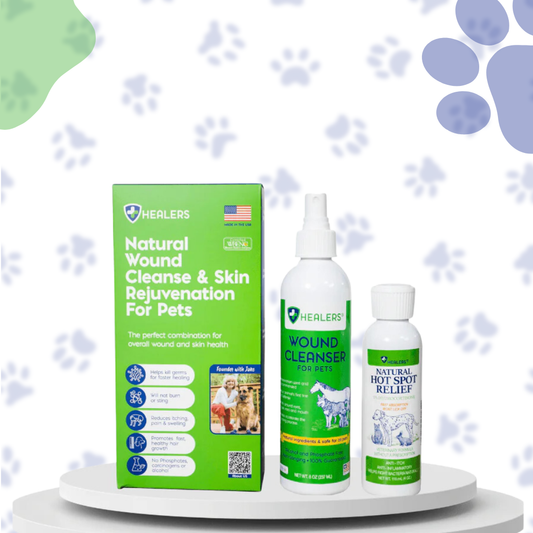Guide for Healing Hot Spots
If you have ever had an insatiable itch on your skin, like a really bad mosquito or horse fly bite, then you know how the smallest incessant irritation can cause a problem. Your go-to move is likely to rub or scratch the impacted area, but that itch can turn painful the longer it lasts. You might even put an ointment on it after a while to help alleviate your discomfort, allowing a topical cream to provide you with a solution.
Hot spots are no joke for pets, but your four-legged friend doesn’t have the option to grab a tube of ointment to alleviate their discomfort when the irritation gets too bad. Uncomfortable burning or itching on their skin often leads to them repeatedly licking, rubbing, scratching, or chewing the impacted area to solve the problem, but those reactions often just make it worse. Untreated and continuously irritated hot spots eventually become inflamed and raw, and can even get so bad that they bleed or get infected. None of this is conducive to healing, and can lead to even worse problems the longer the hot spots go untreated.
The good news is that hot spots are treatable and that providing relief for your favorite furry friends is easier than you think. Read on to learn more about what causes hot spots, how to identify and treat them, and what you can do to help. prevent them from happening to your pets in the future.
What Causes Hot Spots and How to Identify Them
A hot spot is a skin irritation that veterinarians often refer to it as “moist dermatitis.” It occurs when bacteria, fungi, and other irritants impact a particular spot and irritate it. This can happen after a wide variety of life events — from a swim in a lake or a walk in the rain to right after a bath — and typically happens because your pet’s skin is not fully dry afterward. Bacteria or other factors irritate the moist skin, causing a small sore that gets increasingly irritated with time and your pup’s attempts to alleviate it.
Your pet likely has a hot spot when:
- You notice he or she is repeatedly scratching or licking the same spot.
- A certain area of his or her body seems tender to the touch.
- You can see a patch of red skin when you carefully pull his or her fur back to examine an irritate spot.
- His or her skin is red or oozing from excessive irritation.
The important thing to remember is that hot spots are largely treatable, typically with topical ointments or antibiotics. Particularly bad cases might result in hair loss or infection, so it is crucial to begin working to resolve hot spots as soon as you find them.
How to Treat a Hot Spot
When your pet develops a hot spot, the first step toward treating it is identifying where it is. Carefully brush the fur around the impacted area with your fingers to see the extent of the irritation, being mindful that the skin is likely very sensitive. You will know if it is something that can be treated topically once you can see how large and inflamed it is.
Holistic, topical treatments are very effective at alleviating hot spots. They include ingredients to soothe irritation and kill bacteria, helping to reduce the swelling and pain as well as stop the cause in its tracks. Here are a few of our favorites:
- We offer a veterinary-formulated Hot Spot Relief cream with hydrocortisone and tea tree oil that quickly stops the itch through a professional-strength blend of ingredients. The hydrocortisone helps reduce inflammation and irritation, which helps ensure your pet doesn’t feel the need to bother the area with licking or scratching, and jojoba oil and aloe vera moisturize skin to keep it from drying out. The cream can be used as needed to stop the itch and allow hot spots to heal.
- We also offer a CBD Hot Spot Relief cream that provides calming pain relief for sore and sensitive skin while reducing hot spot itching, redness, and overall irritation. It contains 50mg per ounce of pure, hemp-derived CBD, and is safe and effective for all pets. The CBD oil provides an added calming effect for improved healing and reduced inflammation. Phone orders only for this product, so be sure to give us a call!
What matters most is stopping the irritation so your pet has relief, which will keep him or her from licking, scratching, or chewing on the inflamed area and making it worse. Using a solution that also contains antibacterial properties will start to reduce bacteria growth, helping your favorite fur baby get back to optimal health in no time.
When in Doubt, Call Your Vet!
If you are still not sure what to do about your pet’s hot spots, or are worried those irritations might have moved beyond at-home holistic treatments, it might be time to call a professional. It’s never a bad idea to contact your veterinarian when you have questions or concerns! He or she will likely speak with you over the phone or examine the impacted areas during an in-office visit and make sure no additional treatment protocols are needed.
Here’s to keeping pets healthy throughout the year!





